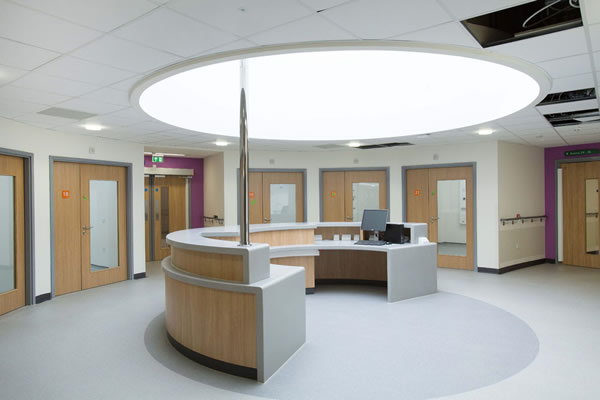 By Chris Topham, Abtec Building Technologies.
By Chris Topham, Abtec Building Technologies.
The Northumbria Specialist Emergency Care Hospital is England’s first 24/7 emergency care hospital. Modern approaches to care have been reflected in the hospital’s design with most of the beds in single en-suite rooms. That modern approach extends to the building’s environment and lighting controls – behind the scenes the hospital has over 3200 KNX devices and 6000 DALI luminaire fittings.

Abtec’s role in the project began in 2012. It was employed to design, program and commission the KNX network and lighting control packages. The hospital’s entire lighting uses DALI over KNX to deliver sophisticated, interactive lighting control. The lighting design complies with CIBSE Lighting Design Guide L2 specification, and emergency lighting testing and reporting is now a scheduled automated process.
Abtec’s KNX engineers created several areas of integration with other building control protocols. For example, the building’s third party access control system now integrates with lighting and climate control, such that access cards no longer just open doors – they also trigger lighting and heating in certain rooms.
Project Scale
Delivering a project of this scale demanded excellent KNX and project management skills. Phil Peer, Abtec’s lead Project Engineer explains, “Getting the KNX infrastructure design right was critical. We envisaged many changes throughout the project, so we designed an infrastructure that was flexible enough to respond to change.”
To make the KNX addressing, programming and ongoing management much easier, the team created 38 KNX IP clusters, or universes, that span the length of the hospital. Peer continues, “Each KNX device has around 20 data points that we need to pull out, and with 3500 devices that’s a lot of data points to manage.”
Most of these devices were used to deliver integrated room and building control such as HVAC, lighting and access control – the typical applications one would expect from a large-scale KNX project.
The Internet of Things
An interesting element of this project was the use of third-party devices that had to be integrates with the KNX network. These devices monitored life-critical hospital services, including:
• Anaesthetic gas pressure.
• Bloods fridge temperature.
• Platelet agitators
Each of these devices is monitored, and when set points are breeched, for example anaesthetic gas pressure is too low (indicating the need to restock), alarms are triggered to an internal facilities management team and external agents.

This is a great example of why KNX is ideally suited to the Internet of Things. Its vast range of gateways and devices, coupled with its low-cost cabling means that it can connect with more things, regardless of location.
KNX also offers another benefit; telegram prioritisation. This means that alarm signals from the life-critical services can be prioritised over other KNX telegrams. These priority signals traverse the KNX, IP and BACnet networks to reach the internal Siemens’ Desigo building management system. The alarms are then sent to an external monitoring team via a secure private network connection. All of this occurs in just a few milliseconds.

Abtec’s team sees the extension of KNX into the Internet of Things as a natural progression of the protocol. Currently, there is no standard transit or communications protocol for IoT, which plays into another KNX strength, namely interoperability.
Conclusion
Making the move to monitoring and controlling non-traditional devices presents additional challenges. Phil Peer explains, “In this project we made plenty of time to thoroughly research the third-party devices. We learnt what information could be output and how KNX could interpret this.” In fact, Phil and his team have created the following top tips based on their experience from the project:
Tip one: Examine the devices early in the project
It is unlikely that the device will have a native KNX interface, so you will have to spend time working with the manufacturer in examining the device’s circuit boards in order to identify how to physically connect it to KNX.
Tip two: Measure the metrics
Make sure that you have a clear understanding of what can be measured and controlled. In this example, Phil’s team was triggering control events based on the change of state of numerous circuit board gated terminals, which was sufficient for the project. It will be difficult to meet your project’s expectation without understanding the output of the device.
Tip three: Test, test, test
Build in plenty of time to test the device. Abtec found it useful to create a small mock-up of the network in order to ensure that the priority signal could traverse over the different transit protocols.
The hospital opened, on schedule, in June 2015, and is already helping to improve the chances of survival for patients. This project shows how KNX can go beyond room and building control by being used to monitor critical resources. KNX is not only helping to make patients’ stay more comfortable, it is integral to the safe running of the hospital.
Chris Topham is Head of Marketing for Abtec Group. The Abtec Group includes Abtec Building Technologies Ltd, a building automation organisation and Abtec Network Systems Ltd, an IT networking specialist for the construction industry.












